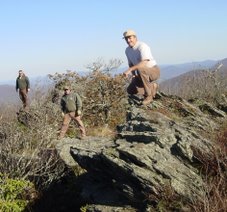In order to give a good answer, one must turn the tables and ask the inquirer a long list of questions: What kinds of animals are you trying to attract/feed? What time of year do you want to plant? How much acreage do you have available to plant? Is it an upland or bottomland site? Does the area get full sunlight or is it mostly shaded?What kind of equipment do you have available? What kind of vegetation is currently present? What will the grazing pressure be like?
Many entire books have been written on the subject, and there is no way to give good advice on planting for wildlife without knowing all of the above information (and more.) The agricultural work that we do involves managing the openings on game lands for the benefit of all forms of wildlife. For example, some openings are managed mostly for the benefit of small game, some are managed with the goal of providing quality forage for deer and other herbivores, and some are planted mostly to attract doves or other birds. Planting itself is only a small part of the work done in managed openings, other work includes plowing or disking, fertilizing, spraying, mowing, burning, managing the field edge, and removing rocks, stumps, and other debris.
Last year we planted a total of 86.5 acres on District 7 game lands. These plantings were done in seven months of the year and consisted of an amazing variety of crops. Here is a list of the different plant seed that has passed through our "seed room" and has been planted on game lands in recent years:
Alfalfa
Alyceclover
American Jointvetch
Arrowleaf Clover
Austrian Winter Pea
Barley
Berseem Clover
Big Bluestem
Birdsfoot Trefoil
Black Eyed Susan
Browntop Millet
Buckwheat
Chickory
Chufa
Corn
Cowpeas
Crimson Clover
Crown Vetch
Durana Clover
Eastern Gammagrass
Egyptian Wheat
Fescue*
Grain Sorghum
Hairy Vetch
Illinois Bundleflower
Indiangrass
Kale
Kobe Lespedeza
Korean Lepedeza
Lablab
Ladino Clover
Little Bluestem
Maximillian Sunflower
Oats
Okra
Orchard Grass*
Partridge Pea
Predovic Sunflower
Proso Millet
Rape
Red Clover
Rye
Ryegrass
Sesame
Sesbania
Small Burnett
Soybeans
Switchgrass
Timothy Grass
Turnips
Weeping Lovegrass*
Wheat
White Dutch Clover
Yellow Sweetclover
*note that these grasses are generally not recommended in wildlife openings, we only use them in erosion control situations.

Above is a photo of the interior of our seed room.
The NC Wildlife Resources Commission used to provide seed in annual and perennial mixtures that was intended for use as a small game food and cover planting. This program ended in the early 1990's, we no longer have any seed available to the public.

No comments:
Post a Comment